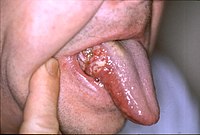
Photo from wikipedia
Objective To apply a deep learning object detection technique to CT images for detecting cervical lymph nodes metastasis in patients with oral cancers, and to clarify the detection performance. Methods… Click to show full abstract
Objective To apply a deep learning object detection technique to CT images for detecting cervical lymph nodes metastasis in patients with oral cancers, and to clarify the detection performance. Methods One hundred and fifty-nine metastatic and 517 non-metastatic lymph nodes on 365 CT images in 56 patients with oral squamous cell carcinoma were examined. The images were arbitrarily assigned to training, validation, and testing datasets. Using the neural network, ‘DetectNet’ for object detection, the training procedure was conducted for 1000 epochs. Testing image datasets were applied to the learning model, and the detection performance was calculated. Results The learning curve indicated that the recall (sensitivity) for detecting metastatic and non-metastatic lymph nodes reached 90% and 80%, respectively, while the model performance recall by applying the test dataset was 73.0% and 52.5%, respectively. The recall for detecting level IB and Level II metastatic lymph nodes was relatively high. Conclusions A system that has the potential to automatically detect cervical lymph nodes was constructed.
Journal Title: Oral Radiology
Year Published: 2020
Link to full text (if available)
Share on Social Media: Sign Up to like & get
recommendations!